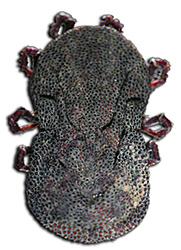Ornithodoros spp.
Ornithodoros moubata/porcinus - Eyeless or hut or warthog tampan
Ornithodoros ticks are vital for the persistence of African swine fever virus (ASFV) in its natural environment in eastern and southern Africa and are intimately involved in the transmission of the disease. Warthogs serve as carriers of ASFV but the viraemia in these animals is usually very low. Transmission to domestic pigs is therefore the result of infected ticks feeding on them. Transovarial and trans-stadial transmission of ASFV occurs andthe virus may also pass from male to female ticks via venereal transmission: during mating via the exospermatophore.

Ornithodoros moubata spp. |
Ornithodoros spp. also transmit Borrelia duttoni, the causative organism of African relapsing fever in humans. This infection is transmitted from human to human by means of the coxal fluid that is produced while the tampan is feeding and thus contaminates the feeding wound. Furthermore these ticks transmit Borrelia anserina the causative organism of fowl spirochaetosis and Aegyptianella pullorum to chickens.
Hosts of Ornithodoros moubata are humans, poultry, domestic pigs and warthogs. The ticks of the moubata complex are widely distributed in the savanna regions of southern and eastern Africa where warthogs occur. The species has been recorded in Uganda, Kenya, Tanzania, Zambia, Zimbabwe, South Africa, Malawi, Mozambique and Namibia, although in most of these countries, as the density of human habitation increases, they are only present in relatively small areas, and mostly within wildlife reserves. The ticks are spread via their nymphal stages, which are commonly found on warthog foraging outside their burrows. Further north they probably occur in southern Sudan and the Somali ecosystem that incorporates parts of north-eastern Kenya, southern Somalia and southern Ethiopia, where warthogs still occur in relatively large numbers. Likewise they may occur further westwards in the Democratic Republic of Congo, the Central African Republic and Chad, but these ticks occur at best infrequently in West Africa.
Infection of O. moubata complex with ASFV occurs naturally in adults and all nymphal stages and ranges between less than 1 and 2 per cent. Rates of infection increase slowly with each developmental stage but with an abrupt increase, usually six-fold, between the last nymphal stage and the adults. It is believed that primary outbreaks are initiated by live warthogs carrying infected ticks onto land used for foraging of pigs or that warthog carcasses, such as animals shot by hunters, could do the same for enclosed premises.
